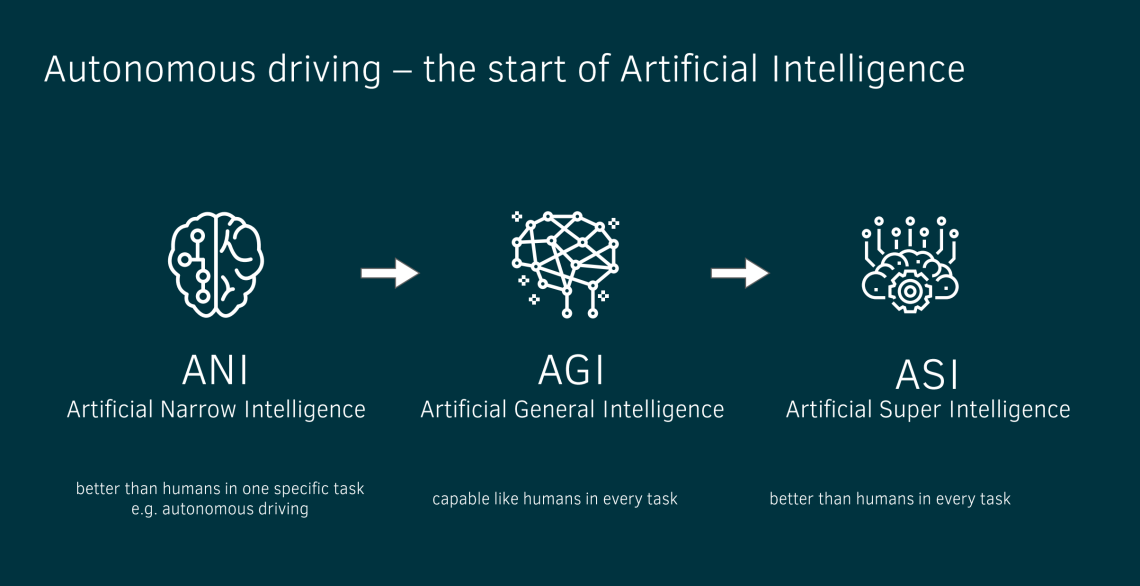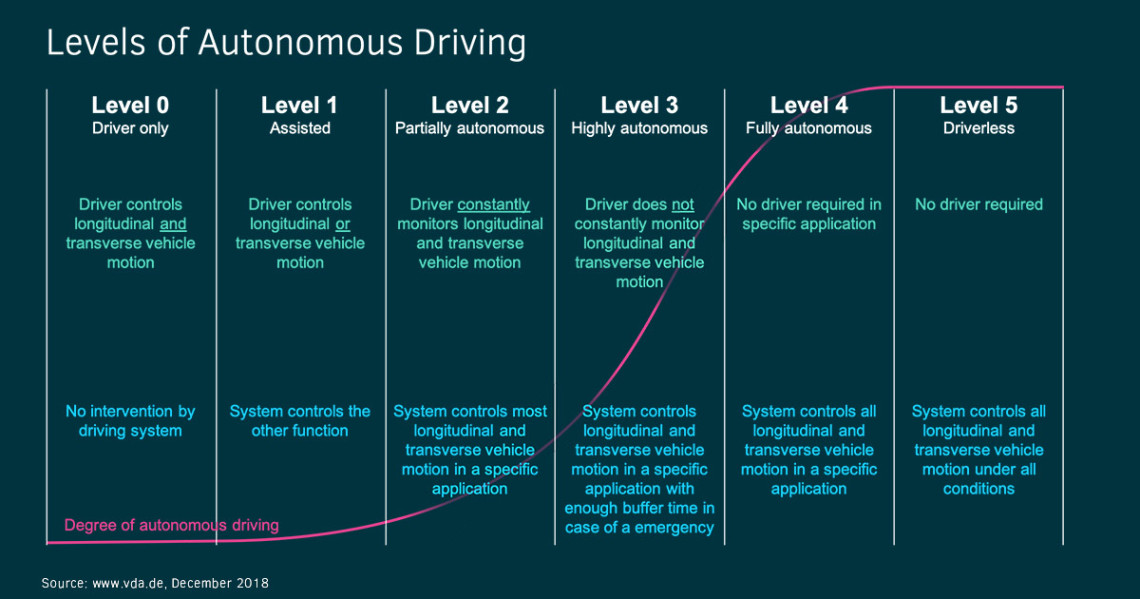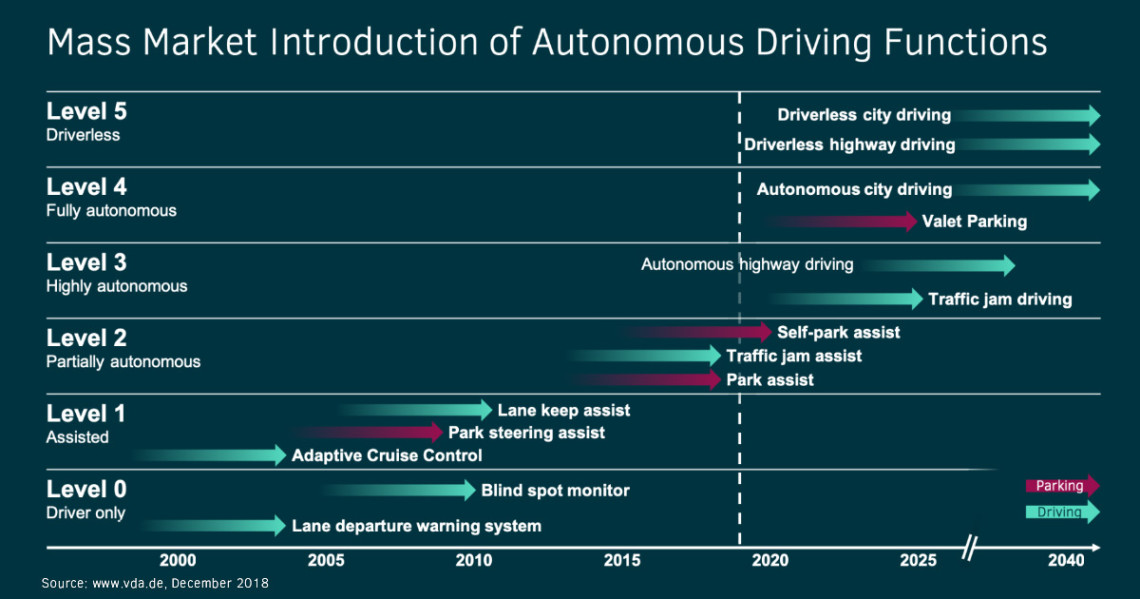Autonomous Driving- One step closer to artificial intelligence
At first glance the driverless vehicle seems to be a rather new idea, but in fact it is already a century old. In 1918, the newspaper Oakland Tribune mentioned in one of its reports the "Motor Car of the Future": "The new car will be [...] controlled entirely by a set of push buttons." In the past century, the automobile expanded its potential from a mere means of transportation into a mobile living space.
The vision of automated driving has existed for almost as long as the automobile itself. The future of yesterday is about to become the reality of today and tomorrow. Automation is therefore more than the realization of a long-cherished vision - it lays the foundation for successfully overcoming the many challenges we are currently facing as a society when we are thinking about the mobility of the future.
In the last decade, the topic of autonomous driving was taken from a side interest of some IT-specialists and brought into the spot light, as today’s technology seems to be able to overcome the existing hurdles and has the potential to be the first step to real autonomous vehicles on our streets. To understand what autonomous driving is all about, we first need to zoom out of its scope and have a look at the topic of general artificial intelligence instead.
Autonomous driving as a subcategory of Artificial Intelligence
Autonomous vehicles can be classified in the main categories of artificial intelligence. The classification of these categories is still controversial - the definition of artificial intelligence is an ongoing discussion. In some cases, it is defined as the ability to solve problems independently, in some as the ability to imitate human intelligence or human behavior and in others by the ability of ethical judgement equivalent to those of humans.
Artificial intelligence can be classified into the following three sub-areas:
- Weak Artificial Narrow Intelligence (ANI): Artificial intelligence that is on a par with human intelligence in specific areas or exceeds it. It is also referred to as weak AI.
- Artificial General Intelligence (AGI): AGI is the term used to describe an artificial intelligence that is equal to human intelligence in all areas. It is also referred to as strong AI.
- Artificial Super Intelligence (ASI): Artificial intelligence that exceeds human intelligence in all areas.
In the following picture you can see the transition from one category to another.

Figure 1: Autonomous driving as a part of Artificial Intelligence
Systems that can be classified as AGI or ASI haven’t been developed to this day, so let’s instead focus on those that have: at the current technological level, there are only systems classified as ANI. Existing examples for ANI are for example AlphaGo as part of Google DeepMind. The company made worldwide headlines in 2016 after defeating for the first time a human professional player in a game of Go.
Another example for artificial intelligence is the military target system of close-range defense of approaching missiles. Finally, autonomous driving in its predicted final stage will be classified under ANI - it is intended to be capable of a better control of vehicles than humans.
The five levels of autonomous driving
Autonomous driving as part of ANI can be further subdivided in the following five levels.
- Level 0: A car which is driven by a human driver without any assistance.
- Level 1: Assisted driving, but the driver has to constantly drive by himself and be aware, e.g. Adaptive Cruise Control (ACC).
- Level 2: Partly autonomous driving, where the car is driving by itself and the driver has to be constantly monitoring, e.g. Tesla’s Autopilot.
- Level 3: Highly autonomous driving, where the car is driving completely by its own and the driver must only intervene in a specific time when the situation requires it. This could be confined to specific situations, road types, ranges of speed or other conditions, e.g. Audi’s Traffic Jam Pilot.
- Level 4: Fully autonomous driving, which is defined by a car driving completely on its own. This level could however also be confined to specific situations, similarly to level 3.
- Level 5: Driverless autonomous driving. On this last level, a car is able to drive, even without a driver, under all the conditions it has to deal with.
The association of German car manufacturers (VDA) defined these 5 levels quite differently.

Figure 2: The five steps to autonomous driving. Source: Verband der Automobilindustrie Deutschland, www.vda.de
An outlook on autonomous driving
At present, OEMs offer assistance systems in many of their vehicles such as adaptive cruise control or automatic parking which are classified as autonomous driving level 1. Right now, level 2 is the sweet spot for many auto manufacturers: Tesla’s Autopilot, Cadillac’s Super Cruise and Mercedes’ Drive Pilot, only to name a few. With level 2 autonomous driving, existing assisting systems can be developed to further take over the wheel, but all without the need for redundancy.
Redundancy plays a big role in highly automated driving on level 3 and further on, as its one of the regulations these systems need to comply with. One of the biggest problems is the transfer of responsibility to the system. A level 3 system has to be able to drive foresightedly for a certain period of time.
In order to achieve this, it needs a lot more sensors to be able to detect its environment reliably and a lot more intelligence to be able to process the information recorded by the sensors correctly. Both are currently posing major challenges for vehicle manufacturers.
Moving up the ladder, the current state of technology gets blurry: names like Waymo and Tesla are mentioned, cars like the 2019 Audi A8 are thrown in the arena, some incidents involving autonomous vehicles crashing are mentioned. The VDA, German Association of the Automotive Industry, suggests a timeframe of up until 2025 for autonomous driving level 3.

Figure 3: Time horizon of autonomous driving. Source: Verband der Automobilindustrie Deutschland, www.vda.de
It’s a fact that autonomous driving is currently at the limits of what is feasible. The introduction of complex systems is often underestimated, especially when they have obvious advantages. Autonomous driving is associated with enormous developmental, process-related and monetary challenges for the OEMs, but also with social and societal challenges that can only be indirectly influenced by the OEMs. To be ready for this future means to constantly evolve. We at accilium are helping OEMs to implement frameworks and business models. We operate in the three pillars of OEMs, the energy and the public sector working on the future of our mobility. Therefore, accilium is the ideal partner to get ready for the digital future.
Article published by Daniel Kolb, accilium
